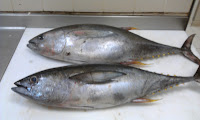
I have eaten loads of croissants in my time. The recipe and the method have always been a bit of a mystery. For those of us who have always worked with pastry chefs and bakers, generally your skills with sweet food stagnate after bread and butter pudding. Definitely I am in that category , I'm crap at desserts and have never made a croissant in my life.Its been a bit of a journey with these and its certainly far from over. Because I work with lots of french people, croissants are very close to their hearts. Everyone here is an expert on eating them, but I've had a hard job to find anyone that's good at making them.

So first we start with the mixture, You need T45 flour and one of a good quality. Fresh yeast, white refined sugar, inverted sugar (Trimoline) milk, cold water and salt. I wont give out the exact recipe as it belongs to a certain pastry chef who is needless to say a nice guy but protective of his work. I think that describes most pastry chefs!!! Activate your yeast with the milk and sugar and mix all the ingredients together. We leave the mix running in this particular machine for 7 minutes.
 Its really important to get the right butter. Margarine wont incorporate well enough and you end up with an oily croissant.
Its really important to get the right butter. Margarine wont incorporate well enough and you end up with an oily croissant.
Cut the dough into 5 equal pieces and then using a dough break or a rolling pin and a really keen eye, roll flat and turn twice to start adding layers to the dough.



At this point the dough returns to the fridge for 5 hours for the butter to incorporate. Once incorporated return to the dough break or marble slab and roll again

Its at this point you add the last lot of butter, ever wondered why they tasted so good!!! 500g per 1.8kg of dough. Roll again to incorporate the last lot of butter and then cut into triangles to roll the croissants. As with most doughs and particularly ones with fresh yeast its important to keep them cold as possible whilst your working with them.

Roll the croissants up and either stock them or allow them to prove. We have a fridge set at 14c and a prover set at 55 so they can slowly rise over night and then get a final blast before baking.
Eggwash goes on just before the oven.
Cook at 180c for about 10-12 mins your looking for a golden colour and cooked all the way through, or they'll sink again.
Im pretty happy with my first attempt, nice and crusty and a good flavour. Croissants from scratch Done!!!
 Start with a light stock syrup and blend the chillis into it. Ive also put a couple of peppers in as well for the colour. Pass through a muslin bag or fine chinois and put into a pan. We use a setting agent called Agar Agar. Derived from algae it very hard and holds until a high temperature. Its best use is for caviar and very thin sheets as its very strong and on mass its like eating rubber! Rule of thumb is 100mls of liquid to 1G of agar. Best to use drug scales for this as you need to be accurate.
Start with a light stock syrup and blend the chillis into it. Ive also put a couple of peppers in as well for the colour. Pass through a muslin bag or fine chinois and put into a pan. We use a setting agent called Agar Agar. Derived from algae it very hard and holds until a high temperature. Its best use is for caviar and very thin sheets as its very strong and on mass its like eating rubber! Rule of thumb is 100mls of liquid to 1G of agar. Best to use drug scales for this as you need to be accurate.




 Place the hot liquid in a squeezy bottle or piping bag and squirt over frozen oil( or at least oil from the freezer) As the liquid cools in the oil it sets in small round drops. Once cold rinse off and its ready to use.
Place the hot liquid in a squeezy bottle or piping bag and squirt over frozen oil( or at least oil from the freezer) As the liquid cools in the oil it sets in small round drops. Once cold rinse off and its ready to use.













































